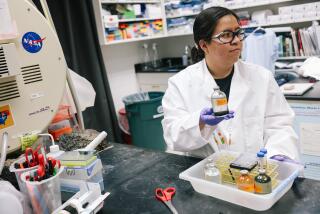Program Brings JPL Technology Down to Earth
High technology has yet to supply a real solution to the weighty problems of managing warehouses that long have nagged manufacturers and high-volume retailers.
Developments like just-in-time inventory control system, robot gofers and computer-managed shelving systems have brought some important savings in time and labor. But those systems all have their shortcomings. Most warehousing operations still rely on the low-tech technique: a human on a forklift.
What businesses want is an automated system that is flexible enough to manipulate continually changing inventories of all shapes and sizes that wonât be confused by the addition of a new part to the piles, or stumped by the haphazard placement of one crate among others.
You might as well teach a robot to walk on Mars.
Indeed.
Robot on Drawing Board
Engineers at the Jet Propulsion Laboratory in Pasadena are trying to build a such a Martian rover that will be able to navigate never-before-seen terrain without having to pause every few steps and wait at least 45 minutes for instructions from an Earth-based manipulator. The robot will need to see the three-dimensional terrain, interpret what it saw and make its own judgments, so that it can move about with needed autonomy and accomplish its exploration tasks efficiently.
The kind of stereo-optic vision and complex computer programming it takes to operate such a robot--problems now being worked on at JPL for a future unmanned visit to Mars--could just as easily be used to make robotic warehousemen a reality, said Tom Walters, JPLâs manager of technical utilization. The lab, operated by the California Institute of Technology for the National Aeronautics and Space Administration, is the premier design and control center for planetary exploration.
It is just such cross-fertilization of technology that is the heart of a new program being coordinated by RIMTech. The group, the Research Institute for the Management of Technology, is a nonprofit arm of SoCalTEN, a networking organization for Southland high-tech executives formed three years ago.
Funded by NASA, State
The program, which is being funded by NASA, a grant from the state Department of Commerce and fees from participating companies, is scheduled to be introduced today by officials of the participating agencies. Already, four Orange County makers of computer systems and peripherals, Alpha Microsystems, AST Research, CalComp and Emulex, have joined the program, paying a one-time $25,000 fee.
In the program, the companiesâ executives meet with program administrators and engineers at JPL to discuss ways in which the labâs technology can be utilized in the companies. The fee pays for the programâs administration and the engineersâ time but does not give the companies exclusive rights to the technology.
From the beginning, NASAâs charter has included a mandate to pass technology developed in the tax-supported laboratories on to the private sector. And in many cases, that has been done successfully. The NMR (nuclear magnetic resonant) brain scan techniques used in modern medicine is just one example of a technology, developed at JPL, now in widespread use.
But often, private business has found the process to be frustratingly long and cumbersome, according to Steve Panzer, president of RIMTech. Often, contract negotiations between NASA and businesses have taken six to eight months to complete.
In the past, the most common method used by NASA to disseminate technology know-how has been to build data bases and to publish information and patent descriptions, said JPLâs Walters.
Japanese companies, he said, have in some cases taken better advantage of that information than U.S. companies--partly because, unlike U.S. companies that have concentrated on building businesses based on proprietary technology, they have relied more on non-exclusive techniques. Japanese companies also have been quicker to implement the available technology.
Also, most of NASAâs technology transfer programs have been set up so that the engineers and administrators have to go out and market available technology to business--a system awkward for both the scientists and the business community they seek to reach.
âThe programs in which the labs go out into industry, by and large, have failed,â said Andrew Paterson, vice president of RIMTech. âJPL recognizes that their great strength is in unmanned space exploration--they donât know industry and we do.â
Said Panzer: âYou cannot take technology and push it into the marketplace.â
In the RIMTech program, the company executives describe their top three or four problems or priorities to JPL, and a brainstorming session follows in which JPL engineers and company officials explore ways in which JPL technology can be applied to those situations.
âRather than us go out and peddle the technology,â said JPLâs Walters, âweâd much rather the companies bring their problems to us.â
Because NASA has approved the program and the fees are paid up front, the joint efforts can proceed faster. âWe can move at a pace that entrepreneurial companies move at,â said Paterson.
The program hopes to have 12 participating companies within a year, although it will accept as many as 20. âWe have to be very careful weâre doing this right, and so we want to go slowly at first,â said Panzer. âPlus, we have to document what we doâ because the JPL/RIMTech program hopes to be a model for future technology transfer projects.
The state Commerce Department has made a $25,000 grant to the program from its Economic Development Loan and Grant Fund. Christy Walters, Commerce director, believes the program is a good way to help stimulate job growth in the state.
For the companies that participate, she said, âthis is a cheap way of buying engineering talent that some of these companies otherwise could never afford.â
The state has a stake in nurturing these small companies, Walters said, âbecause small businesses are creating the most job growth in the state.â In the last 10 years, manufacturing jobs in the state have increased by 20%; almost half of that has been in electronics.
Employment opportunities created by small companies are growing by âleaps and bounds,â she said.
More to Read
Inside the business of entertainment
The Wide Shot brings you news, analysis and insights on everything from streaming wars to production â and what it all means for the future.
You may occasionally receive promotional content from the Los Angeles Times.






